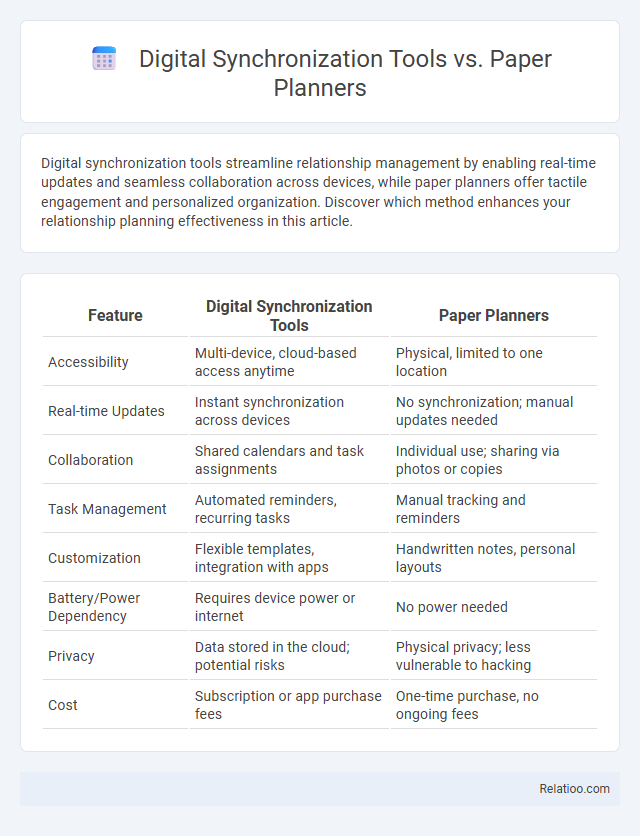Digital synchronization tools streamline relationship management by enabling real-time updates and seamless collaboration across devices, while paper planners offer tactile engagement and personalized organization. Discover which method enhances your relationship planning effectiveness in this article.
Table of Comparison
| Feature | Digital Synchronization Tools | Paper Planners |
|---|---|---|
| Accessibility | Multi-device, cloud-based access anytime | Physical, limited to one location |
| Real-time Updates | Instant synchronization across devices | No synchronization; manual updates needed |
| Collaboration | Shared calendars and task assignments | Individual use; sharing via photos or copies |
| Task Management | Automated reminders, recurring tasks | Manual tracking and reminders |
| Customization | Flexible templates, integration with apps | Handwritten notes, personal layouts |
| Battery/Power Dependency | Requires device power or internet | No power needed |
| Privacy | Data stored in the cloud; potential risks | Physical privacy; less vulnerable to hacking |
| Cost | Subscription or app purchase fees | One-time purchase, no ongoing fees |
Introduction to Digital Synchronization Tools vs Paper Planners
Digital synchronization tools offer efficient, real-time updates across multiple devices, ensuring seamless access to your schedule anywhere. Paper planners provide a tactile, distraction-free method ideal for those who retain information better through handwriting and visual cues. Your choice between digital tools and paper planners depends on whether you prioritize connectivity and automation or simplicity and manual control.
Core Features of Digital Synchronization Tools
Digital synchronization tools offer real-time updates, seamless cloud integration, and multi-device accessibility, ensuring your schedules and tasks are always current and accessible anywhere. Unlike paper planners, these tools provide automatic reminders, collaborative features, and intelligent organization based on your preferences. Leveraging advanced synchronization technology, digital tools streamline task management by minimizing manual input and enabling synchrony across calendars, emails, and project platforms.
Unique Advantages of Paper Planners
Paper planners offer tactile engagement that enhances memory retention and cognitive processing, providing users with a personalized organizational experience unmatched by digital synchronization tools. Unlike digital platforms that rely on device dependency and software updates, paper planners ensure uninterrupted access and reduce screen time, promoting mental clarity and focus. Their customizable layouts allow for creative flexibility and immediate visualization of schedules, fostering a deeper connection with time management.
Efficiency and Productivity Comparison
Digital synchronization tools offer real-time updates, cloud integration, and seamless cross-device access, significantly boosting efficiency and productivity compared to traditional paper planners. Paper planners provide tactile engagement and minimize digital distractions but lack automatic synchronization, leading to potential time gaps and manual updates. Synchronization across digital platforms enhances task management, collaboration, and timely reminders, enabling users to optimize workflows and maintain productivity in dynamic environments.
Accessibility and Portability: Digital vs Paper
Digital synchronization tools offer unparalleled accessibility by enabling instant updates across multiple devices and cloud platforms, ensuring users can manage schedules anytime and anywhere with internet access. Paper planners provide tactile simplicity and do not rely on battery life or connectivity, making them highly portable and reliable in offline scenarios but limited in real-time synchronization and collaboration. The choice between digital and paper hinges on the user's need for seamless, immediate access versus offline functionality and the physical presence of traditional planners.
User Experience and Personalization
Digital synchronization tools offer seamless integration across devices, providing real-time updates that enhance Your user experience through customization options like reminders and shared calendars. Paper planners deliver tactile satisfaction and creative flexibility, allowing personalized layouts and annotations that suit individual preferences without digital distractions. Synchronization between digital tools and paper planners bridges the gap, enabling users to enjoy the best of both worlds by maintaining organized schedules with personalized efficiency and adaptability.
Collaboration Capabilities in Digital Tools
Digital synchronization tools excel in collaboration capabilities by enabling real-time updates, shared access, and seamless integration across multiple devices and platforms. Unlike paper planners, which limit collaboration to physical sharing and manual updates, digital tools support instant communication, task assignment, and progress tracking among team members. These features enhance productivity and coordination in remote and hybrid work environments, making digital synchronization essential for modern teamwork.
Environmental Impact and Sustainability
Digital synchronization tools reduce paper waste by eliminating the need for physical planners, significantly lowering your environmental footprint. Paper planners demand constant consumption of trees, ink, and water, contributing to deforestation and pollution. Choosing synchronization apps promotes sustainability through energy-efficient cloud storage and minimizes resource depletion compared to traditional paper-based options.
Security and Privacy Considerations
Digital synchronization tools offer real-time data updates and cloud backup, but they require robust encryption and secure authentication to protect Your sensitive information from breaches. Paper planners provide offline security with no risk of hacking or data leaks, yet they lack synchronization capabilities, potentially risking data loss or accessibility issues. Synchronization processes must prioritize end-to-end encryption and user control over data sharing to balance convenience with strong privacy protections.
Choosing the Right Planning Method for Your Needs
Digital synchronization tools offer seamless integration across devices, real-time updates, and customizable alerts, making them ideal for dynamic schedules and collaborative projects. Paper planners provide tactile engagement and reduce digital distractions, often enhancing memory retention for users who prefer handwritten notes. Your choice between these methods depends on your workflow, need for accessibility, and preference for digital convenience or analog simplicity.

Infographic: Digital Synchronization Tools vs Paper Planners
 relatioo.com
relatioo.com